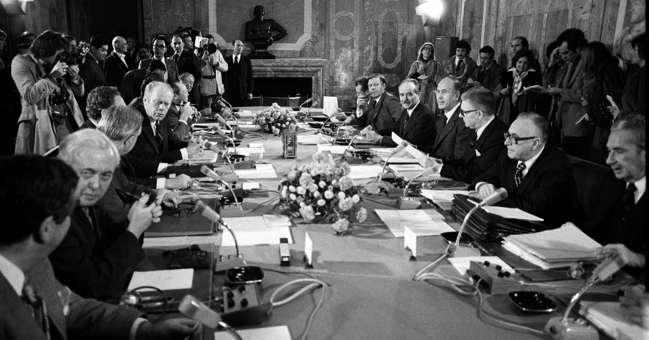From Rambouillet to Brussels
The history of the G7
As the world reeled from the first oil shock and subsequent financial crisis, the heads of state and government of the six leading industrial countries met in 1975 for the first time to discuss the global economy. They were joined in 1976 by Canada and in 1998 by Russia. Following the Russian annexation of Crimea, the G7 nations decided in March 2014 to meet without Russia until further notice.
 1975 saw the first meeting of the heads of state and government of the leading industrial nations in Rambouillet
Source: Bundesregierung/Schaack
1975 saw the first meeting of the heads of state and government of the leading industrial nations in Rambouillet
Source: Bundesregierung/Schaack
The idea for the first meeting was the initiative of French President Valéry Giscard d’Estaing and Chancellor Helmut Schmidt. In 1975 they instigated the first summit meeting at the Chateau de Rambouillet, 50 kilometres south-west of Paris.
At the summit the heads of state and government of France, West Germany, the USA, Japan, the United Kingdom and Italy discussed the oil shock, the financial crisis and the ways out of recession. At this first G6 summit, they adopted a 15-point communiqué, the Declaration of Rambouillet, and agreed to meet in future once a year, under a rotating Presidency. In 1976 Canada joined the group, which henceforth became known as the G7.
Direct talks between the G7 and the European Community were held for the first time in London in 1977. The President of the European Commission was invited to attend the G7 summit. Today the President of the European Council also attends the summit meetings.
Global economy and international politics
The G7 was born as a result of the huge economic problems facing the world in the 1970s. The first oil shock and the collapse of the Bretton Woods fixed exchange rate system had the world on tenterhooks. These were grounds enough for the heads of state and government to consult on international economic policy.
In the 1980s the G7 extended its interests to embrace foreign and security policy issues. International challenges at that time included the long-standing conflict between Iran and Iraq and the Soviet occupation of Afghanistan.
The role of Russia
After the end of the East-West conflict, the G7 invited Mikhail Gorbachev, the General Secretary of the Communist Party of the Soviet Union, to talks in London in 1991, parallel to the G7 summit.
Russia then regularly attended the summit meetings until 2013. In 1998, Russia was formally admitted to the group, making it the G8. At the Birmingham summit, Russia became a member of the Group of Eight leading industrial nations.
2014 saw the break: as a result of Russia’s violation of the sovereignty and territorial integrity of Ukraine, the heads of state and government of the G7 decided not to attend the planned G8 summit in Sochi under the Russian Presidency. The G7 nations will not attend G8 summits until Russia changes course and an environment is once again created in which it is possible for the G8 to hold reasonable discussions.
Rather than meeting in Sochi, the G7 member states met for the first time in 16 years on 4 and 5 June 2014 in Brussels. Germany has since held the G7 Presidency and will continue to do so until the end of 2015. The G7 summit will be held in June 2015 at Schloss Elmau.

